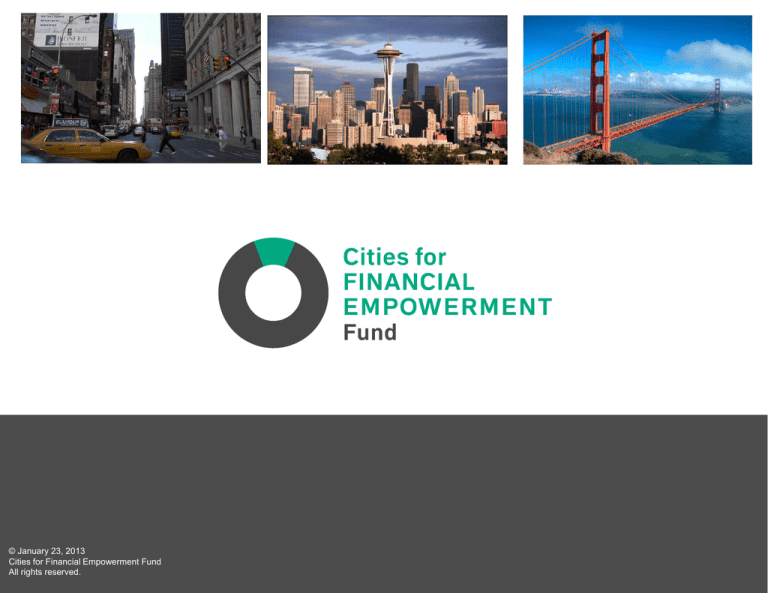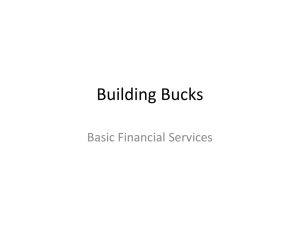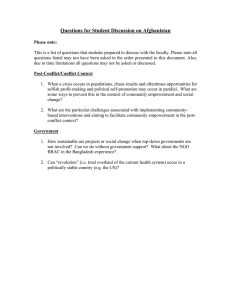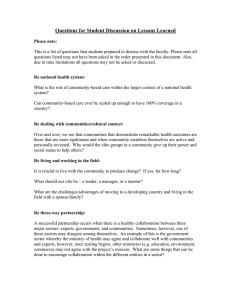
© January 23, 2013
Cities for Financial Empowerment Fund
All rights reserved.
www.cfefund.org
Financial Empowerment Center
Counselor Training Curriculum
Topic 2: Banking and Basic Financial Transactions
www.cfefund.org
Questions to Think About
• What are the different types of depository financial
institutions?
• What are the different accounts offered? How do you know
which one is the right fit for your clients?
• What are fringe financial services and how do these differ
from financial institutions?
• What are the necessary steps to maintain an account?
© January 23, 2013
Cities for Financial Empowerment Fund
All rights reserved.
www.cfefund.org I 3
Choosing An Institution
1.
Banks
•
•
•
•
2.
For profit
Insured by the FDIC
Owned by investors/shareholders
Profits paid to the investors
Credit Unions
• Not for profit
• Owned by members
• Insured by the National Credit Union Share Insurance
Fund (NCUSIF)
• Profits normally go to reduce fees, interest rates
3.
To choose wisely, compare fees, rates of return,
services offered
© January 23, 2013
Cities for Financial Empowerment Fund
All rights reserved.
www.cfefund.org I 4
Basic Bank Services and Products
Opening an Account
US Patriot Act – Know your customer rules
Banks are required to verify accountholder identity
How this is done varies from institution to institution
Documentation needed
Government issued identification
(US Government-issued or Foreign Government-issued;
varies by financial institution)
Tax identification number – SSN or ITIN
Proof of address
© January 23, 2013
Cities for Financial Empowerment Fund
All rights reserved.
www.cfefund.org I 5
Questions to Ask When Choosing an Account
1.
What fees are charged for maintenance and use of the account?
2.
How many transactions are allowed each month? What is the cost per additional
transaction?
3.
Is there a required minimum balance?
4.
Are deposits insured and up to what amount?
5.
Does this account earn interest?
6.
Are there additional charges (e.g., printing checks, stop payment on checks, use
of ATM, getting assistance in person or on the phone)?
7.
Are there hidden fees? BEWARE of fee-based overdraft services!
8.
How do these fees compare with what your client currently pays for
banking/check-cashing services?
© January 23, 2013
Cities for Financial Empowerment Fund
All rights reserved.
www.cfefund.org I 6
Types of Accounts
• Basic Starter Accounts
• Checking Account
• Savings Account
• Investments
• Certificates of Deposit
• Money Market Accounts
© January 23, 2013
Cities for Financial Empowerment Fund
All rights reserved.
www.cfefund.org I 7
A partnership of banks, credit unions, and community organizations to
connect people to affordable checking and savings accounts and high
quality financial education.
Checking and savings accounts with these features:
Low opening deposit requirement
No monthly minimum balance
No (or low) monthly fee
Free ATM or debit card
Savings account
Direct deposit
Online banking, if available
Accept Mexican Matricula card as primary form of ID
$50 - $100 incentives for completing financial education requirements (at 3
participating institutions)
Outreach and financial education brochures translated into 12 languages
Affordable small dollars loans offered by 2 participating financial institutions
Find a bank or credit union at www.everyoneiswelcome.org or call 2-1-1
© January 23, 2013
Cities for Financial Empowerment Fund
All rights reserved.
8
www.cfefund.org I 8
Barriers to Bank Accounts
ChexSystems
Chex Systems, Inc. provides account verification services to its financial
institution members to aid them in identifying account applicants who may
have a history of account mishandling (for example, people whose accounts
were overdrawn and then closed by them or their bank).
Each report submitted to ChexSystems remains on file for five years.
Clients can order a report to learn what information, if any, is listed in their
consumer file at ChexSystems. If they have been denied an account from a
bank or credit union, and ChexSystems was used in the decision process, this
information will help them understand what may have contributed to that
decision. You are entitled to a free copy of your consumer report, at your
request, once every 12 months
© January 23, 2013
Cities for Financial Empowerment Fund
All rights reserved.
www.consumerdebit.com
9
www.cfefund.org I 9
Financial Education
Seattle-King County Financial Education Providers Network with 20+
member organizations improving quality and access.
Online at www.EveryoneIsWelcome.org:
Directory of non-profit agencies
Calendar of free classes
Helpful Links and Resources (financial education curricula)
Search for classes, workshops, and one-on-one help on
bankruptcy, basic banking, budgeting, credit counseling,
foreclosure prevention, homeownership, ID theft, loans, starting a
new business and tax assistance
Help Bank on Seattle-King County customers choose tools and features
to avoid overdraft and insufficient fund fees.
$50 - $100 savings incentives for Bank on Seattle-King County customers
who complete financial education requirements (offered by 3 financial
institutions).
© January 23, 2013
Cities for Financial Empowerment Fund
All rights reserved.
10
www.cfefund.org I 10
Checking Account
Checking Account – Transactional accounts facilitate regular payments
through paper checks, internet banking and bill payment. Payments are
drawn against amounts on deposit:
Making Deposits
Direct Deposit – Regular, electronically transmitted, funds available immediately
Signing back of the check for deposit
Writing Checks
Written words prevail over numbers
Cancelled Checks – Checks which have been paid by drawer’s bank are returned to
drawer (now in electronic form)
Check Register – Record of all deposits, withdrawals, fees deducted, and checks issued
Balancing check book – Adding all deposits and deducting all checks issued, withdrawals
and fees to know what is available to be drawn against
© January 23, 2013
Cities for Financial Empowerment Fund
All rights reserved.
www.cfefund.org I 11
Checking Account
Checking Account Statement – Institution’s report of all transactions issued on a
periodic basis (usually monthly)
Reconciliation with Bank Statement – Comparing check register and statement
to account for all outstanding checks
Bill Payment
Automatic arrangement to pay regular bills from account
Online payments made each time bill becomes due
ATM Card – An Automated Teller Machine Card may be issued in connection to a
checking or savings account to allow consumer to transact business (i.e. deposits,
withdrawals, transfers & check balances)
May be fees associated with it
Point of Sale vs. Signature-Based Transaction
Costs and benefits of having a checking account
© January 23, 2013
Cities for Financial Empowerment Fund
All rights reserved.
www.cfefund.org I 12
ATM Card - Automated Teller Machine Card
• Issued by account holder’s bank
• Allows account holder to conduct business transactions
(withdraw, deposit, transfer between accounts) using an ATM
(of issuing financial institution or other)
• May be a fee for transactions conducted using ATMs of nonissuer financial institution
• May be a charge imposed by issuer if ATM transactions
exceed stated limit each month
• May be the same card as the consumer’s debit card
• No credit card logo (Master Card/Visa) if dedicated ATM card,
cannot be used at point of sale
© January 23, 2013
Cities for Financial Empowerment Fund
All rights reserved.
www.cfefund.org I 13
Debit Cards
• Debit Cards may be linked to existing accounts or
purchased as pre-paid.
• Fees: Point of Sale - using debit card and a PIN
number; monthly fees; annual fees; or charge if
exceed set number of uses (Account linked card
combines ATM and Debit features where there is a
Visa/Master Card logo)
• Trap: Some institutions hold a multiple of the
debited amount – making less of balance available
until transaction clears
© January 23, 2013
Cities for Financial Empowerment Fund
All rights reserved.
www.cfefund.org I 14
Reloadable Prepaid Debit Cards
• Structured to not only spend but also add money as if
adding to a checking account
• Most cards charge higher fees than the basic checking
accounts offered at mainstream financial institutions
• Difficult to identify all the fees included such as:
Adding money
Calling customer service
Getting a paper statement
• Make sure the card is fully FDIC insured and offers
Regulation E protections.
• Opting for a checking account over a prepaid card may
still be a better deal
© January 23, 2013
Cities for Financial Empowerment Fund
All rights reserved.
www.cfefund.org I 15
Paying Through Debit vs. Credit
• Debit Card – Money is
withdrawn directly from
account holder’s own
funds, e.g. savings or
checking: no balance, no
access
• Credit Card – Payment is
made by issuer on
consumer’s behalf, to be
paid by consumer as
invoiced
© January 23, 2013
Cities for Financial Empowerment Fund
All rights reserved.
www.cfefund.org I 16
Checking Account
• Overdraft – When a checking account goes below a zero
balance.
Overdraft Protection Plans – Banks cover transactions when
the account has a negative balance with fees possibly
exceeding the payment itself!
This is extended not only to checks but also ATM and debit card
transactions
The median overdraft fee is $27 (APRs of 1,000 – 3,500%)
Consumers may be unaware they have overdrawn their
accounts.
BEWARE OF FEE-BASED OVERDRAFT PROTECTION PLANS!
There are other options to explore.
© January 23, 2013
Cities for Financial Empowerment Fund
All rights reserved.
www.cfefund.org I 17
Alternatives to Fee-Based Overdraft
• Overdraft line of credit
Consumers can apply for an overdraft line of credit and pay interest on
the money used to cover overdraft just like any other type of loan.
Banks may also charge annual fees.
• Linked savings account
When the checking account is overdrawn, banks will automatically take
funds from savings account to cover the transaction.
Banks may also include transfer fees.
• Linked credit card
Any overdraft amount becomes a cash advance on the credit card.
Consumers will probably be charged a cash-advance fee, and interest
charges on the advance will start immediately.
© January 23, 2013
Cities for Financial Empowerment Fund
All rights reserved.
www.cfefund.org I 18
Overdraft Regulations
• Financial institutions can not automatically enroll
customers into their overdraft protection services for ATM
and one-time debit transactions
• They need to ask consumers for permission, or to “opt in.”
• Some banks have discontinued the practice, others are
aggressively marketing the services to consumers.
• The message is simple: “It’s best not to opt in” It’s
important to know the consequences.
© January 23, 2013
Cities for Financial Empowerment Fund
All rights reserved.
www.cfefund.org I 19
Recommendations to Consider
• If you already have a checking account, find out through
the financial institution if you are enrolled in overdraft
protection.
• If you have already opted in to overdraft protection, figure
out if this is something worthwhile to retain.
• Consider more affordable options for covering overdrafts
from checks or ongoing debit transactions.
• When opening a checking account, it’s best not to opt in
to overdraft protection.
© January 23, 2013
Cities for Financial Empowerment Fund
All rights reserved.
www.cfefund.org I 20
Tips for Avoiding Overdrafts
• Keep track of all transactions, including ATM withdrawals,
electronic payments and debit transactions.
• Don’t forget to subtract any transaction fees.
• Monitor the account balance and stay up to date on which
transactions have cleared.
Check by calling the bank or by looking online or at an
ATM
• Beware of debit holds
Using a debit card at a restaurant, gas station, hotel or
car rental agency may cause a “hold” to be placed on
the account at an amount greater than the purchase
(holding a multiple of the debited amount).
© January 23, 2013
Cities for Financial Empowerment Fund
All rights reserved.
www.cfefund.org I 21
Savings vs. Investments
Savings
• Funds set aside for short term needs (usually
defined as one year or less)
Investments are long term
• Assets acquired for future income or benefit
• Increase by generating income (interest or
dividends)
• Grow by appreciating in value
• Income earned and appreciation in value increases
wealth
© January 23, 2013
Cities for Financial Empowerment Fund
All rights reserved.
www.cfefund.org I 22
Savings vs. Investments
• Liquid savings readily available as cash and not
intended for long-term investment
• Illiquid savings – “forced savings,” e.g. over
withholding income tax in order to get a big refund
Strategy often employed by poor
May stunt ability to build wealth or manage
funds
© January 23, 2013
Cities for Financial Empowerment Fund
All rights reserved.
www.cfefund.org I 23
Watch Your Money Grow
1.
Calculating Interest Earned:
Principal (P) x Rate (R) x Time (T) = Simple Interest (I)
a) Generally on an annual basis – apportion if period is less
than one year
b) Example:
P = $100
R = 2%
T = 1 yr.
$100 X .02 X 1 = $2.00
Interest = $2.00
To calculate 1 month of
interest, divide $2.00 by 12
months.
$2.00 / 12 = $.16 for one month
© January 23, 2013
Cities for Financial Empowerment Fund
All rights reserved.
www.cfefund.org I 24
Watch Your Money Grow
2.
Compound Interest:
a) Interest earned on principal over time, plus interest earned on
the interest.
Example:
In 2011, Maria kept a $100 deposit (P) for the full year (T) and
earned a 2% interest (R).
P x T x R = Interest at the end of the year
($100) x (1yr.) x (.02) = $2.00
On January 1, 2012, she would have $102. Assuming she left
$102 on deposit for the entire 2012 year, on January 1, 2013
she would have a yield of $104.04.
© January 23, 2013
Cities for Financial Empowerment Fund
All rights reserved.
www.cfefund.org I 25
Watch Your Money Grow
3.
Rule of 72:
a) Calculation of time it takes for money to double at a
given rate of return
b) Assumes compounded interest annually
a) Divide 72 by rate of return = time it takes for money to
double
b) For example if Client X earns 10% on her money, it would
double in 7.2 years (72 divided by 10 = 7.2 year)
© January 23, 2013
Cities for Financial Empowerment Fund
All rights reserved.
www.cfefund.org I 26
Time – The Advantage of Starting NOW
STARTING TO SAVE EARLY – Assume a 3% Return
•
The following example shows you what a difference starting to save early can
make.
In this case, we have student “A” beginning to save $1,000 per year beginning at
the age of 16. By the time that “A” is 25 years old, she has saved $10,000. If she
never puts any more of her own money into the account, at the rate of 3% per
year, Student “A” will have $38,517.33in her account by the time she is 50 years
old. In other words, for her input of $10,000, she has gotten a return of
$28,517.33.
•
Compare what happens to student “B” who does not start to save until he is 26
years old.
Assuming “B” saves $1,000 per year for 25 years, at the rate of 3%, by the time
“B” is 50 years old, he will have input $25,000 to have $36,323.01 in the account.
His return on his input of $25,000 is only $11,323.01. In other words, Student “B”
put in two and half times the money that Student “A” did and yielded less half of
the money that Student “A” yielded.
© January 23, 2013
Cities for Financial Empowerment Fund
All rights reserved.
www.cfefund.org I 27
Time
The Advantage
of Starting
NOW
© January 23, 2013
Cities for Financial Empowerment Fund
All rights reserved.
www.cfefund.org I 28
Savings Account
• Generally interest bearing
• Saving with Automated Transfers from checking, or
payroll
• Automated Teller Machine (ATM) card to electronically
transact business (withdrawals, deposits, transfer funds
among accounts)
• Debit Card – Can be used to make purchases - funds
directly withdrawn from account (also applies to
checking accounts)– usually combined with an ATM card
and will carry a Master Card or Visa logo
© January 23, 2013
Cities for Financial Empowerment Fund
All rights reserved.
www.cfefund.org I 29
Certificate of Deposit
Certificates of Deposit or “Time Deposits”
• Certificate evidencing a deposit for an agreed fixed
term (date of maturity) at an agreed fixed rate of
return or interest
• Short or medium term (generally 3 months to 6 years)
• Generally higher rates of return
• Money removed before maturity date is subject to
penalty
© January 23, 2013
Cities for Financial Empowerment Fund
All rights reserved.
www.cfefund.org I 30
Money Market Accounts
Money Market Accounts or Money Market Mutual Funds
• Saving account with some characteristics of money
market fund
• Federally insured
• May offer same services as checking account with
limitations
• Higher interest rates than savings accounts, with higher
minimum balance
© January 23, 2013
Cities for Financial Empowerment Fund
All rights reserved.
www.cfefund.org I 31
Choosing the Right Account Based on Needs
• Checking Accounts – Necessary to transact daily
business of paying bills, and centrally gathering funds
before allocating for expenses, savings and expenses
• Savings Accounts – Putting aside funds for short term
goals with some interest yield
© January 23, 2013
Cities for Financial Empowerment Fund
All rights reserved.
www.cfefund.org I 32
Choosing the Right Account Based on Needs
• Certificates of Deposit – Short term goals, do not need
immediate access to funds, low tolerance for risk (as
compared to stock market) looking for predictable
higher return than regular savings account
• Money Market Accounts – May need access to funds
through a checking facility, short terms goals, collect
low amount of interest
© January 23, 2013
Cities for Financial Empowerment Fund
All rights reserved.
www.cfefund.org I 33
How Does Banking Help Take Control of Finances?
• Banks are for-profit financial institutions
• Credit Unions are non-profit financial institutions
• Checking Accounts – Interest rates, overdraft fees,
etc.
• Savings vs. Investments
• Money Market Accounts & CDs
• Comparing accounts, fees, earnings, etc.
• Consumer Needs
© January 23, 2013
Cities for Financial Empowerment Fund
All rights reserved.
www.cfefund.org I 34




